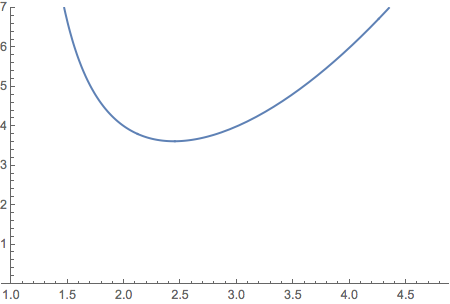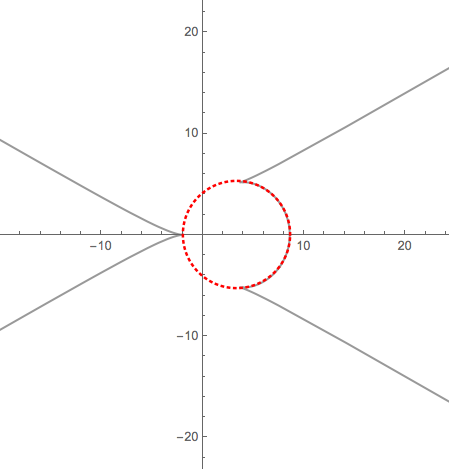Here is another, more pedestrian approach to solving the OP's problem.
ξ[r_, a_] := (-2 a^2 - 2 a^2 r + 6 r^2 - 2 r^3)/(a (-2 + 2 r))
η[r_, a_] := Sqrt[-((r^3 (-16 a^2 + 36 r - 24 r^2 + 4 r^3))/(a^2 (-2 + 2 r)^2))]
ParametricPlot[{{-ξ[r, 2], η[r, 2]}, {-ξ[r, 2], -η[r, 2]}}, {r, -10, 10},
PlotStyle -> Black,
Exclusions -> {-1, 1}]

By observation of the plot, it is clear that one of the points we are looking for is the zero of η[r, 2] near -ξ[r, 2] = 8. Lets, solve for it.
Solve[η[r, 2] == 0, r] // N
{{r -> 0.}, {r -> 4.82164},
{r -> 0.58918 + 1.72373 I}, {r -> 0.58918 - 1.72373 I}}
We can reject the two imaginary root. Of the two real roots, the one we want is the one that makes -ξ[r, 2] positive.
-ξ[r, 2] /. {{r -> 0.}, {r -> 4.82164}}
{-2., 8.58747}
So r = 4.82164 is one the desired points.
Again by observation, we see the upper cusp is the value of r that minimizes -ξ[r,2] (by symmetry the lower cusp is also at that value of r). We plot -ξ[r,2] so we can eyeball that value of r. Then we compute it more precisely.
Plot[-ξ[r, 2], {r, 1, 4.8},
PlotRange -> {Automatic, {0, 7}},
Exclusions -> {1}]

My eyeball says we should look for the minimum near 5/2.
FindMinimum[-ξ[r, 2], {r, 5/2}]
{3.62013, {r -> 2.44225}}
So the other two desired points are at r = 2.44225.
We can now make the plot the OP asked for.
ParametricPlot[{{-ξ[r, 2], η[r, 2]}, {-ξ[r, 2], -η[r, 2]}}, {r, -10, 10},
PlotStyle -> Black,
Epilog ->
{AbsolutePointSize[6], Red,
Point[{-ξ[r, 2], η[r, 2]}] /. r -> 2.44225,
Point[{-ξ[r, 2], -η[r, 2]}] /. r -> 2.44225,
Point[{-ξ[r, 2], η[r, 2]}] /. r -> 4.82164},
Exclusions -> {-1, 1}]

Update
Just for fun, let's see if we can show the what the OP calls a "circle-like shape" really lies on the arc of circle. First, I will work purely from intuition. My intuition tells me that arc-like section is indeed the arc of a circle and that the full circle must pass through both zeroes of the parametric curve. If that holds, then the x-coordinate of the center of circle is given by
xcenter = Mean[{-2., 8.58747}]
3.29374
and the radius is given by
radius = xcenter - (-2)
5.29374
Let's see how that works out.
ParametricPlot[{{-ξ[r, 2], η[r, 2]}, {-ξ[r, 2], -η[r, 2]}}, {r, -10, 10},
PlotStyle -> GrayLevel[.6],
Epilog -> {Red, Thick, Dotted, Circle[{xcenter, 0}, radius]},
Exclusions -> {-1, 1}]

Pretty convincing I would say, but we should verify it with a little geometric computation. A few years ago I wrote a function to find the center and radius of the circumcircle of a triangle. It's just what we need. It uses a helper function that, given two points, computes the parametric equation of the perpendicular bisector of the line segment joining the two points.
perpendicularBisectorF[{p1_, p2_}] :=
Module[{midPt, unitPerp, unitPara},
midPt = .5 (p1 + p2);
unitPara = Normalize[p2 - p1];
unitPerp = Cross @ unitPara;
With[{a = midPt, b = unitPerp}, (a + b #) &]]
circumcircle[{p1_, p2_, p3_}] :=
Module[{pb1F, pb2F, center, radius},
pb1F = perpendicularBisectorF[{p1, p2}];
pb2F = perpendicularBisectorF[{p2, p3}];
center = pb1F @ (Solve[pb1F@s == pb2F@t, {s, t}][[1, 1, 2]]);
radius = EuclideanDistance[center, p1];
{center, radius}]
circumcircle[
{{-ξ[r, 2], η[r, 2]} /. r -> 2.44225,
{-ξ[r, 2], -η[r, 2]} /. r -> 2.44225,
{-ξ[r, 2], η[r, 2]} /. r -> 4.82164}]
{{3.41804, 0.}, 5.16943}
So my intuition is confirmed mathematically as well as visually.







NSolve[(D[Rep[{-\[Xi], Sqrt[\[Eta]]}, {a -> 2}], r])[[1]] == 0, r]$\endgroup$